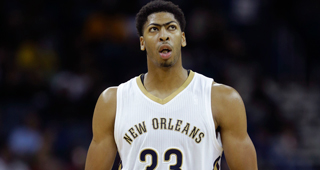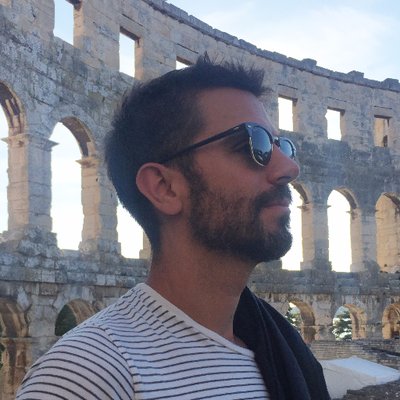Anthony Davis wears No. 23 and has the NBA’s best origin story since Michael Jordan was cut from the varsity when he was a high school sophomore. Reading that story with this visual of Davis in his Perspectives uniform, wearing glasses and working on his game in anonymity as a guard thinking he didn’t have a career in basketball since no scouts were coming to games in his junior season is astounding.
Two years later, Davis entered the NBA as the top overall pick of generational proportion with a national championship and Wooden Award from his season at Kentucky and an Olympic gold medal.
Davis is a basketball treasure that almost never was and is the NBA’s most incredible prodigy (possibly ever) despite that late development in which he almost left the game. Davis is a guard that loves the game and grew into a big just in time, whereas most bigs show up to play without the passion to be great to cash in their lottery ticket.
Davis added muscle in the offseason as well as getting that USA confidence boost we’ve come to expect coming out of the summer for every player going through that program and is on pace to have a historical season statistically. Saying “a comparison of Davis to a young Kevin Garnett is an insult to Davis“ is no longer a blasphemous statement. Unlike Garnett, Michael Jordan and Kobe Bryant, Davis has the drive to become an all-time great without being psychotic in the same way as LeBron James and Tim Duncan. Being around Davis at this critical point in his career, you sense how well he's managing being a normal 21-year-old with his rise in the league.
Davis is simultaneously a savant on offense and defense with the type of overwhelming skill, length and athleticism to impose his force on all aspects of the game even while he’s still growing into one of the most unorthodox players that has ever played the game. Just as we’re figuring out where the limits may be for Davis, we’re watching him write his own tale of opulence. A PER of 35.0 for the season seems as plausible as the four-minute mile mark did before Roger Bannister. His Playstation-worthy per 100 possessions stats are 37.5 points, 16 rebounds, 2.8 assists, 3.2 steals and 5.5 blocks.
In another life, the Hornets were literally and figuratively OKC before OKC, playing games there after Katrina from 2005 until 2007 with a young core of Chris Paul, David West and Tyson Chandler. Paul and West were drafted in 2005 and 2003 respectively, while Chandler came over in the J.R. Smith trade when the Chicago Bulls needed to unload his contract.
The finishing touches of a team that got as far as Game 7 of the Western Conference Semifinals against the San Antonio Spurs came via older free agents like Peja Stojakovic in 2006 and Morris Peterson in 2007. The CP3 Hornets went out with a four-game sweep whimper in 2011 to a flawed Los Angeles Lakers.
This time around, the Pelicans have added pieces around their franchise player that are just slightly older via trade (Jrue Holiday, Omer Asik) and free agency (Tyreke Evans, Ryan Anderson). Austin Rivers is the Pelicans’ only other relevant draft pick and they already declined their third-year option on him, while Eric Gordon has to this point lost the part of his game that made him critical to the Paul trade that predated the arrival of Davis.
Davis didn’t wait to become one of the NBA’s best players and the Pelicans began working on putting a playoff-caliber roster around him immediately after he finished second in Rookie of the Year voting to Damian Lillard. Dell Demps has been the anti-Hinkie, and the Pelicans and Philadelphia 76ers uncoincidentally linked up on draft night of 2013 on a trade that set both franchises off on their current trajectories.
While the trade for Asik caused the Pelicans to forfeit another draft pick and not having younger reinforcements has famously been an issue for the Cleveland Cavaliers in LeBron James’ first tenure with the club and also has contributed to the Lakers falling off a cliff so quickly, the move makes their defense better in a meaningful way while ensuring Davis can roam on that side of the floor. The Pelicans were forced into that trade after clearing cap space to sign Evans by dealing away Robin Lopez. Davis is a havoc wrecker on defense with his activity in deflections and blocks in the paint and on the perimeter. His defensive heat map covers so much floor.
The mix of Holiday, Gordon and Evans on offense, however, is problematic with all three players needing the ball in their hands to be effective while also not possessing the type of pick-and-roll, perimeter shooting or passing abilities that would be ideal with Davis. Holiday and Gordon are certainly passable three-point shooters, but are streaky and won’t kill you relative to the alternative. All three of those perimeter players are a difficult cover individually, but they become easier to stop collectively due to how their games overlap and their inability to stay committed to movement in the halfcourt.
Monty Williams says he’s “preaching ball movement” and wants Davis to “play off the dribble with his passing and ability to make other guys better,” but that rarely happens for the Pelicans in their halfcourt sets. Without Anderson on the floor to create space, Davis is too often stuck in higher degree of difficulty isolations and in the pick and roll, often not initiating that offense until late in the shot clock.
In their road win this week at the Sacramento Kings on the second night of a back-to-back, the Pelicans’ first half offense was an atrocious mélange of low percentage jumpers coming off the dribble after a possession in which there was nearly no ball movement. They turned the game around in the third quarter due to feeding Davis and Anderson on nearly every possession within the Gordon-Davis pick-and-roll, which created a string of wide open looks for Anderson and lanes opening for Evans off the dribble as a byproduct with the defense rotating. If Gordon could consistently become even 85 percent of the pick-and-roll player he was back in 10-11 with Blake Griffin, the Pelicans are making the playoffs and are a scary out.
Davis has talked about how he wants to remain patient on offense, but the Pelicans need to make him the center of their offense as the Dallas Mavericks have with Dirk Nowitzki. Davis has too many ways to unlock a defense not to give him more touches.
The Pelicans don’t have a lineup combination that fully unleashes Davis as the two-way MVP he’s already looking like he is despite the imperfections of the roster. When you consider the fact Davis projects as basically the best elite big man Swiss Army Knife ever, even accidentally stumbling across the right mix of players shouldn’t be too difficult in the long-term
The Pelicans have been above league average on offense with their Davis, Asik, Holiday, Gordon and Evans lineup, but that is largely due to the miracle that is the .618 True Shooting Percentage of Davis.
A three-man frontcourt of Davis, Asik and Anderson can’t work since Anderson can’t defend wings, while the Pelicans are compromising on offense without him on the floor and severely on the defensive end without Asik.
The Lakers had the same issue with Pau Gasol, Andrew Bynum and Lamar Odom during their 2009 and 2010 titles in which Phil Jackson couldn’t play the three together. But unlike Williams, Jackson gave those three all 96 minutes at center and power forward.
Davis has barely enough help to sneak the Pelicans into the playoffs, but he’ll need another superstar to eventually elevate the franchise into title contention. Fortunately, the Pelicans have the NBA’s golden ticket in the certainty Davis will be committed there long-term in 2016 and 2017 when the cap increases and Gordon comes off the books.
In the meantime, with the Pelicans playing just once on national television, Davis deserves a cut of League Pass subscriptions. Watching him and nobody else is worth it at this point. This season will be for Basketball Twitter what Eric Clapton and Pete Townshend talk about feeling when they first heard Jimi Hendrix and they realized that while the instrument was the same, the possibilities of sound were entirely different.



